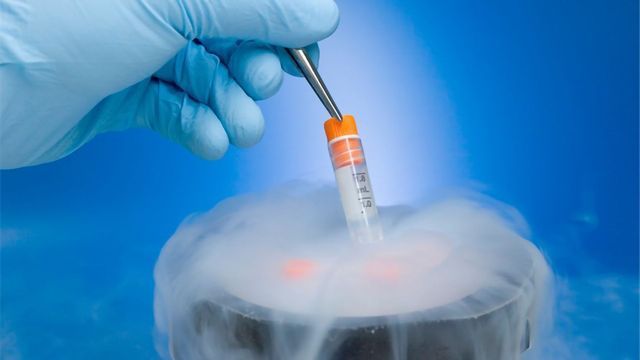
As humans, we have always been fascinated with the idea of immortality. We want to cheat death and live forever. While it might sound like a pipe dream, a German startup called Tomorrow Biostasis is working on a way to preserve human bodies in the hopes of reversing death in the future. The concept of cryopreservation is not new, but Tomorrow Biostasis is taking it to a whole new level. The company’s goal is to preserve the bodies of their clients in a state of stasis until medical advances can treat and reverse their original cause of death, bringing them back to life.[reverse death]
The man behind the ambitious plan is Emil Kendziorra, one of the co-founders of Tomorrow Biostasis. He is a firm believer in the possibility of bringing the dead back to life and is working tirelessly to make that a reality. According to Kendziorra, the company has already cryopreserved about 10 people for training purposes, with hundreds more on the waiting list. The company’s typical clientele are 36 years old on average and tend to work in tech. Some of them want only their brain preserved, believing that their future selves may prefer a new 3D-printed body or not even a body at all.

The process of cryopreservation is not as simple as freezing a body and hoping for the best. The bodies of the clients are transported to Rafz, Switzerland, for long-term storage at the European Biostasis Foundation. The process is technically considered a scientific body donation to make it legal. The bodies are cooled to -196 degrees Celsius and placed inside an insulated tank with liquid nitrogen to lock in the preservation.
But even if the bodies are successfully cryopreserved, the real challenge lies in reviving them. While medical advancements have made significant progress in recent years, bringing a previously dead human brain back to life with regular function and memories is still a far-fetched idea. The process of reviving a cryopreserved human brain is a complicated and intricate one that is yet to be fully understood.
But that doesn’t stop Kendziorra and his team from pursuing their dream. They believe that the rapid advancements in science and technology will eventually lead to the successful revival of cryopreserved humans. While it may sound like science fiction, it’s important to remember that many scientific breakthroughs were once considered impossible.
The idea of cryopreservation [For reverse Death]
The idea of cryopreservation is not a new one. In fact, it has been around for decades. The concept involves freezing a body in a state of stasis, which essentially halts all cellular activity. The goal is to preserve the body until medical advancements can treat and reverse the cause of death, bringing the person back to life.
But the idea of cryopreservation has always been surrounded by controversy. Critics argue that it is ethically questionable to freeze a body with the hope of reviving it in the future. Others believe that the process is simply not practical, as the technology to revive cryopreserved humans may never exist.
Despite the controversy surrounding the concept, cryopreservation has its fair share of supporters. People like Kendziorra believe that it is possible to bring the dead back to life and are willing to invest their time and money into the technology. For them, the possibility of living forever is worth the risk.
But even if the technology to revive cryopreserved humans does exist, there are still many questions that need to be answered. For example, who makes the decision on whether to revive a cryopreserved person? Is it the person themselves, or their next of kin? What about the legal and ethical implications of bringing someone back to life? These are questions that need to be addressed before cryopreservation can become a viable option for the general public.

Despite the many challenges and unanswered questions, the idea of cryopreserving the deceased with the hopes of one day reversing death and restoring life has captured the imaginations of many.
The concept of cryopreservation dates back to the 1960s when the first successful cryopreservation of a small mammal, a rabbit, was accomplished. Since then, cryopreservation has been used for a variety of purposes, including preserving cells and tissues for medical research, organ transplantation, and even the preservation of endangered species.
But the idea of cryopreserving humans with the goal of reviving them in the future is a relatively new one, and it’s one that has sparked both excitement and controversy.
At the forefront of this movement is Tomorrow Biostasis, a startup based in Berlin that is focusing on human cryopreservation. The company’s goal is to preserve the bodies of the deceased using liquid nitrogen with the hopes of one day reviving them when medical technology has advanced enough to do so.
According to Emil Kendziorra, one of the co-founders of Tomorrow Biostasis, the company already has about 10 cases with some bodies preserved in a lab. The company’s “standby ambulance” is also ready to respond as soon as somebody dies, with the goal of preserving their body and/or brain in a state of stasis for future revival.
The company’s typical clientele are 36 years old on average and tend to work in the tech industry, which is not surprising given the focus on technological advancements in cryopreservation. Some of these individuals are interested in having just their brain preserved, with the belief that their future selves may prefer a new 3D-printed body or not even a body at all.
But despite the interest in cryopreservation and the growth of companies like Tomorrow Biostasis, the reality of cryonics is not without its challenges and controversies.
One of the main challenges facing cryopreservation is the lack of knowledge and understanding about how to revive a cryopreserved human. While it’s possible to freeze cells and tissues, bringing a dead brain back to life with regular function and memories is currently beyond our understanding.
Furthermore, the process of cryopreservation itself can be risky. The cryoprotectant used to preserve the cells and tissues can cause damage, and the cooling process can lead to the formation of ice crystals, which can also cause damage.
There’s also the question of who decides when to revive a cryopreserved individual, and how this decision is made. If the goal of cryopreservation is to revive individuals in the future, what if their loved ones have also passed away? Who will be responsible for making the decision to revive them, and how will this decision be made?
Despite these challenges, there are also those who remain optimistic about the potential for cryopreservation to revolutionize the way we approach death and dying.
One such individual is Max More, the CEO of the Alcor Life Extension Foundation, one of the oldest and largest cryonics organizations in the world. More believes that the future of cryonics is bright, and that advances in technology and medical research will eventually make it possible to revive cryopreserved individuals.
“We are confident that science will eventually be able to repair the damage caused by the cryopreservation process and enable restoration of the cryopreserved individual to good health,” More said in an interview with The Guardian.
Others are more cautious, acknowledging the many challenges and unanswered questions surrounding cryonics.
In an interview with Wired, neuroscientist Sebastian Seung expressed skepticism about the feasibility of cryopreservation, stating that “it’s not impossible, but it’s not obvious how to do it.”
For more Visit Blogs :-

BTS Military Enlistment Schedule: When Will the Remaining BTS Members Serve?(latest May 2023) Army sad


